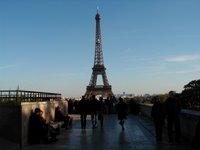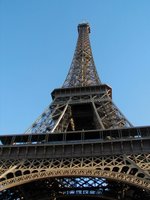


You may already know how reviled this masterpiece was at its completion on this date in 1889, but it always make me wonder what in today's world is similarly hated (objects, concepts, ideas) that will be revered tomorrow. And the reverse--what today is accepted as good or normal that tomorrow will be discarded.
---------------------------------------------------------------------
(From The Writer's Almanac for Friday, March 31, 2006)
Today is the anniversary of the official opening of the Eiffel Tower in Paris (1889). It was built for the International Exhibition of Paris, commemorating the centenary of the French Revolution. At the time, it was the tallest structure ever built, at 1,000 feet. The architect Gustave Eiffel was a specialist in bridges and the design for the Eiffel Tower was based on his previous bridge designs. He chose to leave the tower's skeletal structure exposed because it was the easiest way to protect it from wind resistance.
When it was finished many Parisians thought it was horribly ugly. Artists and writers wrote a letter of protest, calling the tower a "truly tragic street lamp," a "mast of iron gymnasium apparatus, incomplete, confused and deformed."
The writer Guy de Maupassant described the Eiffel Tower as, "A high and skinny pyramid of iron ladders, [a] giant ungainly skeleton upon a base that looks built to carry a colossal monument of Cyclops, but which just peters out into a ridiculous thin shape like a factory chimney." He hated the tower so much that he started eating in its restaurant every day, because, he said, "It is the only place in Paris where I don't have to see it."
It was almost torn down in 1909, after the expiration of its lease, but the city saved it because its antenna was so useful for the new invention of radio. It's now the most widely recognized symbol of Paris.
No comments:
Post a Comment